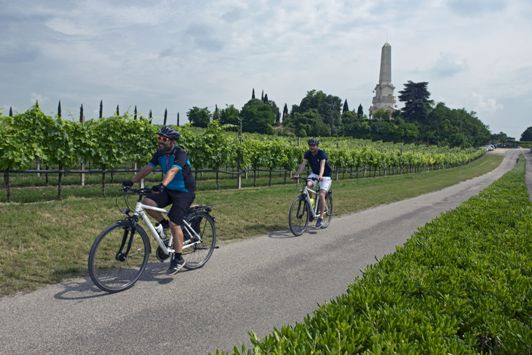HISTORY PATHS – DISCOVER THE TERRITORY IN A DIFFERENT WAY
Experiential bike tours with Bike Experience by Fabio Boeti
Wednesday | The Lands of Custoza, a Bike tour through into the History – From the beautiful historic building “Villa Venier” in Sommacampagna, through an asphalt / dirt road made of secondary roads to low speed and countryside, Bike Experience wants to give you the thrill of discovering the Morenine Hills of Custoza, a unique territory immersed in nature, crossing the historic centers of some characteristic villages of the territory such as Custoza, famous for the wine “Custoza Doc”, but theater of battles for the Italian independence of 1848 and 1866. A journey to rediscover the history of these battles through historic villas and courts where episodes marked the outcome of the clashes between the Austrian armies and the Piedmontese armies before and after Italian one with the striking backdrop of the Ossuary of Custoza where you will be welcomed by our guides; you can also immerse yourself in the reality of such crucial moments for the history of Unification of Italy. A path suitable for everyone where it is possible by reservation to live and discover the typical local products that this territory gives us through a stop in one of the farms in the area.
For information and booking:
HISTORY PATHS – BATTLE OF 1848
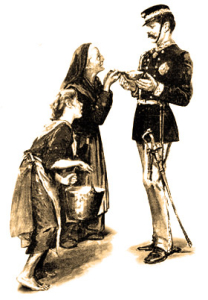
A jump in history, four steps in environments full of suggestions and memories of the past, a land steeped in emotion left by those who fought, suffered, sweat and celebrated.
A journey where the battles were the protagonists of the Renaissance and where history is running next to the major events, history of everyday gestures, tension and hope for a better future. The map will suggest the path that you wish to discover, moment by moment. It will show you the sites of the battles: Villas, churches, countryside, monuments. Vestiges of a period which saw Italy dominated by the foreign. The French who gave way to the Habsburgs during the Congress of Vienna, who ruled with an iron fist. The fire of freedom hatched a long under the ashes; the revolutionary movements often failed due to the lack of adherence to libertarian thought through the people perpetually exploited. Most of the people lived or survived better in ignorance; therefore they found it hard to understand the need for this further struggle. Riots continued, reaching their peak with the Five Days of Milan (March 1848), which saw the victory of the patriots on the troops of Marshal Radetzky, forced to withdraw from the city and then to defend in the Austrian defensive system of the quadrilateral.
It is during April 1848 and June 1866 that these green hills became a battleground for clashes between the Piedmontese and the Austrians. The negotiations for the armistice took place in Villafranca in July 1860; Italy was not unified yet; Verona was annexed to the Kingdom of Italy with a plebiscite in October 1866.
THE STAGES OF THE KEY BATTLES
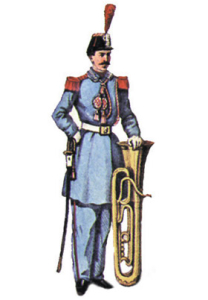
The history of the land and human settlements that were the scene of the liberation of the Renaissance are very old. The historical reports of Sommacampagna dates since 38 BC, when the temple was erected in Leituria, a local deity, in the place where now stands St. Andrew (XI sec.) In the existing cemetery.
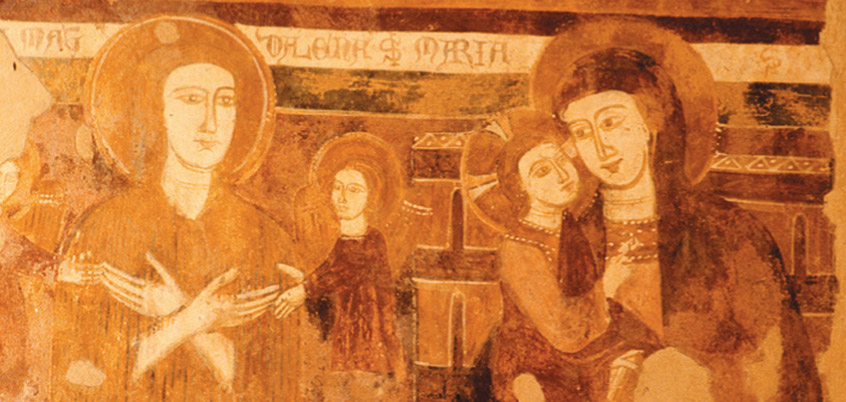
Sommacampagna at that time was a small rural town inhabited by a few shepherds and farmers, next to two major roads: the Gallica and the POstumia. The local landscape was to be that of a small island planted with few trees, cereals, vines and “mela lanata” (modern peach) within a wide area mainly wooded, which fueled the consumption of timber, grazing and hunting. A vital problem was the water, because of the ground. The place must not have undergone substantial changes over a period of time that separated it from the Middle Ages.
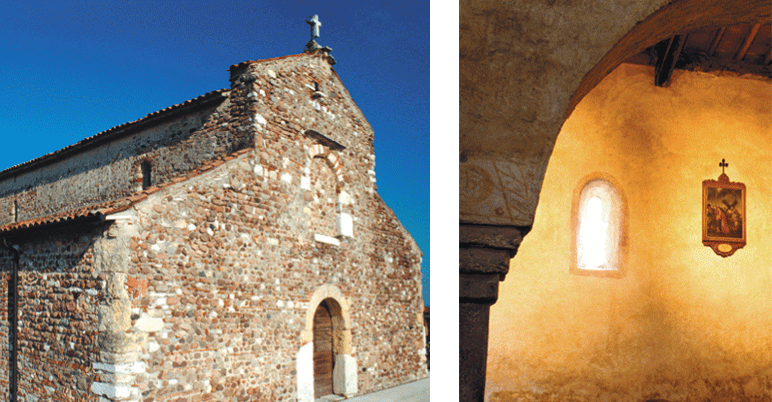
We return to talk about Sommacampagna in a parchment of 1035 where it is mentioned also the parish church of St. Andrew which had a recall on the whole area of the Verona countryside and also on the south-central part of the morenica-gardesana. In the 12th century, the country was a big “pasture bush” divided here and there with scrub oak supporting pig farming, hornbeams, beeches and oaks. The fauna consisted of deer, wild boar, wolves and birds. At that time the settlement had developed around the church. In the 14th century, the area was so poor than all the surrounding areas, including Custoza who was “villa” in itself. Between 1405 and 1797 Sommacampagna passed under the flag of San Marco, which replaced the effigy of Verona. But already at that time the population was indifferent to the domains that alternated, experience had shown that the goodness of crops depended on the strength of those who cultivated the lands and Jupiter Pluvio and certainly not by the political authority. Custoza even during Venetian period maintained its independence and territorial jurisdiction. In 1530 souls living in the two centers were estimated at about 600 units; almost as many were living in Caselle or scattered in the countryside or in the woods. Population growth remained almost completely unchanged: just before the outbreak of the 1630 Sommacampagna were 1450 people of which 704 residents in the capital city, almost all original. At that time 70% of the crop was planted with trees, with a preponderance of the vine and mulberry, all crops were adapted to nitrogen-poor soils such as those on moraine hills. The economic resources were sufficient to ensure the mere survival, nothing more; religion taught to accept the policy ran its own ends. The plague of 1630 found a fertile ground, so much so that Sommacampagna only 240 people survived the virus. Custoza already from 1613 was completely deserted. After a demographic disaster usually explodes birth; In fact, within a generation is returned to the ante-plague population number. A few powerful families, in addition to the nobles, held the most significant slice of the lands, held mostly in the grass or arable land (forage, grain, millet, grapes and mulberry) and used to rent.
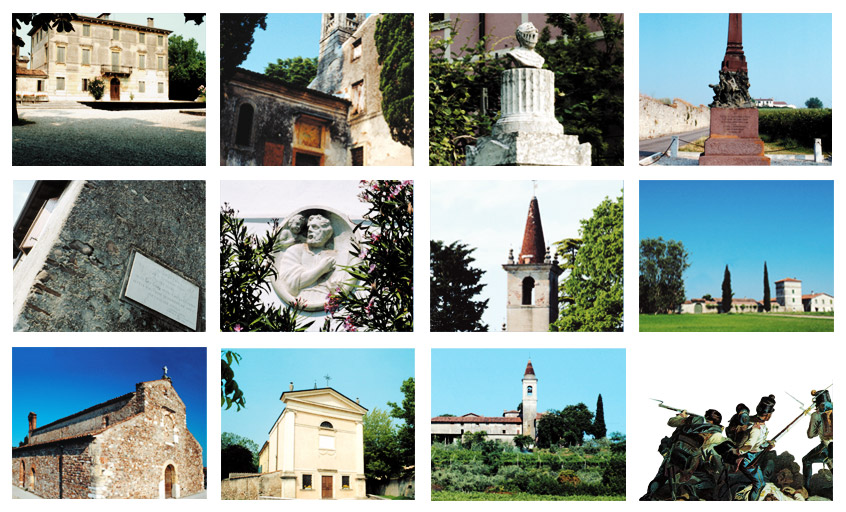
During the 18th century, in the wake of the Venetian fashion, and thanks to the huge assets, many of these powerful families began to build mansions, often extending existing buildings surrounded by lush vegetation. The Venetian culture has left out the most incisive in today; I am witness to the many villas located in the territory. At the time of the fall of the Lion of St. Mark (1795), Custoza remained an independent entity. In the 19th century, the land area and administrative changed four times. At the beginning of 1800 Sommacampagna was a border land. The French who took over in 1801 the Venetians took it as the capital; in 1805, applied the territorial reform, it found itself assigned to the canton of Villafranca, while Custoza became at that time part of the future Municipal. The population held jobs mostly agricultural and commercial activity was modest. Still crops remained unchanged as well as the agricultural landscape. The eagle Habsburg succeeded to the representative of Bonaparte in 1814, changing Planning; Sommacampagna kept Custoza, depending, however, from Villafranca. Even this new master did not bring improvements nor did partaker of the modest benefits that the tax could bring from economic war. The Milan-Venice railway was built in that period, but the station was built in Sommacampagna only in 1854. It was in April 1848 and in June of 1866 which recorded the highest number of foreigners with the arrival of the armies of Savoy and Habsburgs. The events of the first and third war of independence Sommacampagna participated as the scene of clashes, and with the sacrifice of its economy, with suffering and looting. Annexed to the Kingdom of Italy, accepted the new political connotation, even with the painful realization that no government would make life better; as anywhere in the Verona countryside class consciousness was still a privilege, as well as education, not to mention the food.
The difficult life conditions, the close bond that linked the man to the ground, the little or no literacy, made these populations rural, by necessity or impossibility far from large or small games of thrones of parallel worlds, characterized of a fervent religious feeling, where the annual periods were marked by cycles tied to the land and to the liturgical celebrations.

The liturgical calendar at the time of the battles for independence was rich and heard; the charismatic priestly figure was still a point of reference. The archaic rural world has always lived a symbiotic relationship with nature: the physical life was related to meteorological phenomena, the movement of the sun and the moon, the equinoxes and solstices. From the beginning the Church has tried to superimpose the pagan cycle that the Christian liturgy. Many festivals were transformed into Christian holidays; the day of the winter solstice, celebrating the birth of the sun, has been transformed into Christmas party; the day of the vernal equinox, in which the ancients celebrated the death and resurrection of the god of vegetation, who awoke after a long winter sleep, as Easter. And so also for other events: the day of John the Baptist has supplanted the water festival in midsummer; the Assumption, August 5th, the festival of Diana; the recurrence of the Dead in November was the continuation of the ancient pagan festival of the dead. The community responded with festivals or rituals to the highlights of the calendar or the life of man, and found his moment of sharing and re-aggregation, exorcism and strength to continue the hard way. It was an escape from everyday life, the opportunity for the waste in a life-saving, the moment you resume origins, a communal ritual to combat the sense of insecurity and fear. The Saints were familiar figures and protectors, intermediaries between God and the faithful; the cult of the dead equally important and heard. Some holidays, born of pagan rites, have come down to us. The chipping of the old lady (“sego de laVECIA”) for example. Pagan ritual of mid-Lent, which was intended to break the fast and propitiate the perk of life in the camps.
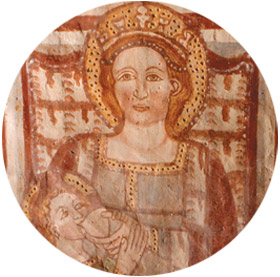
Among the people was running the rumor that, where the old lady passed, cows became infertile, fields parched and wine became vinegar. To avert this apocalypse, the old woman was chased and chipped in two among the crowd. In Custoza, 1952 was the year of the last representation. The whole country was involved in setting the dramatization, which took place in the natural scenery of the hills around the Ossuary and had its epilogue in the valley that separates the two main hills of Custoza. The Bruiel is the custom to set fire on the night of the Epiphany, piles of weeds accumulated in the fields. The bonfires commemorating the fires lit by the Magicians and the shepherds near the house in Bethlehem. There you can see the classic purpose of the fires in the countryside, propitiatory rite for new crops. Another very important festivity was that of “S. Paul of Signs “on January 21. On that date it was believed to be able to divine the weather conditions in the following year. The last evening of February and the early 2 of March young people came to “ciamar marso”, which finds its origins in the magical rites for the rebirth of nature, and the awakening of fertility Sleeping in lethargy during winter. It was an opportunity for young people to announce engagements. Many others were important anniversaries, some have been restored, while the majority keep alive only in the memory of the elders.
Have a nice walk.





